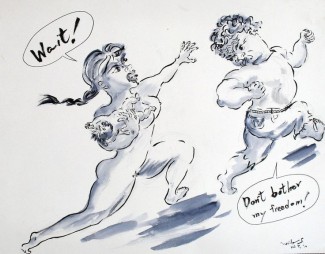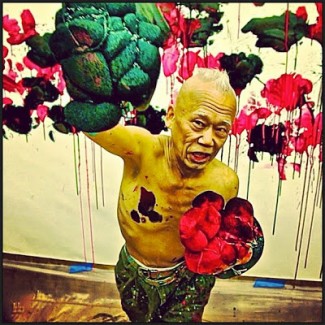Cutie and the Boxer (Zachary Heinzerling, 2013): USA
Reviewed by Daniel Chein. Viewed on Netflix.
This is the second film I am reviewing in a series on Oscar nominated runner-ups for Best Feature Documentary, now available for instant streaming via Netflix. Aside from the 2014 Academy Award winner 20 Feet from Stardom, Cutie and the Boxer is the only film from the short list that is not related to some kind of war.
Cutie and the Boxer is a biographical documentary about two Japanese artists living in New York by director Zachary Heinzerling. The film presents a candid portrait of Ushio Shinohara and his wife, Noriko Shinohara, both of whom immigrated to the US hoping to break into the art scene. Ushio is known for making “action” paintings using boxing gloves and sculptures of deranged motorcycles made out of cardboard. Despite having exhibited at prestigious art museums internationally, Ushio finds himself unable to transcend the barrier from a successful artist to a renowned one, quoted as being “the most famous of the poor and struggling artists in New York.” Now, he is struggling to come to terms with having reached – and perhaps falling from – his peak in terms of artistic development and success.
The story behind the story, however, is actually about his wife, Noriko, and the way Heinzerling introduces her effectively captures the essence of their relationship: defining her life in relation to his. A talented artist in her own right, Noriko’s latest work is a series of illustrations based around a character named Cutie. But Noriko’s side of the story is very different than Ushio’s: having met Ushio while she was still an art student, she was attracted to his relative success, and thought that by being with a famous artist, she would have the opportunity to show her work to the museums, galleries, and collectors, whose influence over the art world can either make, or break, careers. But Ushio was an alcoholic, at least 10 years her elder, and, for the most part, never took his wife’s work seriously. Perhaps in part due to her own cultural traditions and/or in part due to modern society’s double standard for working women, Noriko’s time was divided between raising their kid, household duties, and producing her own art.
Cutie and the Boxer is a beautiful film, and as a viewer I really sympathized with Noriko’s predicament as Ushio’s shadow. They share a very complicated relationship that on one hand seems unfair yet on the other seems to have found its balance, for neither seem entirely unhappy with their lives, finding humor and comfort in each other to mask their bitterness and hardship. This duality is visually manifested in their artworks, with Ushio’s raw, masculine, external emanation juxtaposed starkly against Noriko’s soft, feminine, internal emotion. The film takes place at a pivotal time in their lives and not only illuminates some of the hoops struggling artists have to jump through to make it as a living artist, but also the understated and subtle complexities of true love. By the end, the viewer is left to interpret whether or not Noriko and Ushio – the cutie and the boxer – reach their goals.
About this entry
You’re currently reading “Cutie and the Boxer (Zachary Heinzerling, 2013): USA,” an entry on Student Film Reviews
- Published:
- 04.09.14 / 11am
- Category:
- Films


15 Comments
Jump to comment form | comments rss [?] | trackback uri [?]